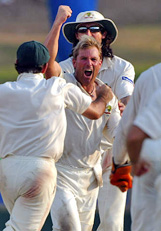COACHING
Spin bowling
Spin bowling is the most subtle art in cricket and it is the most psychologically demanding. The margin of error is less, as the pace of the delivery is slow. However, the slower pace also ensures that slow bowlers do not stray in line and length as much as fast bowlers. To be a successful spin bowler, one has to relax and maintain muscle control. The spinner should not push the ball through, but deceive the batsman by the flight. This might sounf odd, but spin bowlers should work on their relaxation and self-confidence, to achieve benefits like line and length, spin and flight, etc!.
Important bowling skills for spinners are the
bowling action and the ability to turn and flight
the ball. The spinner has to plan well in advance
to meet the challenges and adopt the same according
to the situation. Say, you decide not to allow Sachin Tendulkar to paddle-sweep, but he manages to
do so. You should then change your plan and try and
bowl further outside the off-stump and see what he
does. Thinking like this will make you a better
bowler.
The quality spinner will study the batsman's stance, grip and height and accordingly adjust his line and length.
Vinoo Mankad, one of the greatest left-arm spinners of all time, was a great exponent of the art of spin bowling. I had the pleasure and privilege to keep wickets to him. I have seen his subtle variations from close quarters.
The quality spinner will study the batsman's stance, grip and height and accordingly adjust his line and length.
Vinoo Mankad, one of the greatest left-arm spinners of all time, was a great exponent of the art of spin bowling. I had the pleasure and privilege to keep wickets to him. I have seen his subtle variations from close quarters.
On other occasions, he would bowl three deliveries with varying degrees of flight but a similar length. To achieve Vinoobhai's mastery, the bowler should practise for hours in the nets on his own, or with only a wicketkeeper, under the able guidance of his coach.
The slow bowler has to make maximum use of the bowling crease. He should try to deliver the ball from different angles of the crease to vary his deliveries in their flight and line. He should mix his deliveries, bowling some from close to the stumps, others away from the stumps and some from the corner of the crease as well.
The slow bowler should adjust his flight keeping in mind the end from which he is operating. The 'wind factor' will come into play here - whether he is bowling into the wind or with it, or if it is blowing sideways. The leg-spinner and left-arm spinner should bowl against the wind.

In fact, a bowler who gives the ball a lot of air
should bowl against the wind. Spinners should also
observe the condition of the pitch. On a flat
track, the bowler should give the ball more air,
and on a turner, he should mix his flight with
deliveries of a lower trajectory. Wickets in India
tend to crack as the game progresses, and more turn
can be extracted by pushing the ball flatter. Spin
bowlers should also take advantage of the footmarks
created by the fast bowlers at the opposite end and
bowl the occasional spell from around the wicket.
Shane Warne of Australia and our own Anil Kumble
have succeeded in getting wickets or keeping down
the runs from an 'around the wicket' line.
Successful spin bowlers have always 'hunted' in pairs like fast bowlers. Earlier, Vinoo Mankad and Subhash Gupte did a great job for India. Anil Kumble and Harbhajan Singh have the talent and wherewithal to achieve something similar.
Successful spin bowlers have always 'hunted' in pairs like fast bowlers. Earlier, Vinoo Mankad and Subhash Gupte did a great job for India. Anil Kumble and Harbhajan Singh have the talent and wherewithal to achieve something similar.
If a batsman is playing forward, the spinner should bowl to make him play on the back foot, and vice-versa. If the batsman is playing across the line, the bowler must capitalise on this weakness.
More often, matches are won because of the bowler rather than a batsman. I say this because that is what I have seen happening for years and years, from my position behind the wickets at the batsman's end.